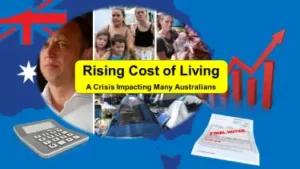
Description:
Rising cost of living Australia. Explore how inflation and price spikes burden Australian families, with solutions debated in parliament.
Introduction
 Australia is facing a significant economic challenge as the cost of living continues to rise, placing immense pressure on families across the nation. Inflation has hit multi-decade highs, and essential goods and services are becoming increasingly unaffordable. This financial burden is not just a statistic; it’s a daily struggle for millions of Australians trying to make ends meet.
Australia is facing a significant economic challenge as the cost of living continues to rise, placing immense pressure on families across the nation. Inflation has hit multi-decade highs, and essential goods and services are becoming increasingly unaffordable. This financial burden is not just a statistic; it’s a daily struggle for millions of Australians trying to make ends meet.
The reality is stark: families are cutting back on essentials, skipping meals, and foregoing medical care to cope with skyrocketing prices. As wages stagnate and prices soar, many Australians are questioning whether the government is doing enough to address this crisis. The fear and frustration felt by families is palpable, and the pressure on household budgets is reaching a breaking point.
This article delves into the complexities of the cost-of-living crisis, exploring its root causes, effects on families, and the solutions currently being debated in parliament. By understanding the full scope of the issue, we can better advocate for policies that will alleviate this burden and ensure a stable and prosperous future for all Australians.
Understanding the Cost-of-Living Australia Crisis
Definition and Scope
The cost of living refers to the amount of money needed to sustain a certain standard of living by covering necessary expenses such as housing, food, healthcare, and transportation. In Australia, the cost of living has historically been influenced by factors like inflation, wage growth, and government policies.
However, in recent years, Australians have seen a sharp increase in living costs, driven by both global and domestic factors. The Australian Bureau of Statistics (ABS) reports that inflation has reached levels not seen in decades, contributing to an overall higher cost of living that affects every aspect of life.
Key Drivers of the Crisis
1. Housing Costs:
The Australian housing market has been one of the primary drivers of increased living costs. With property prices and rents at record highs, many families find themselves dedicating a huge part of their income to housing, leaving less for other essential expenses.
2. Grocery Prices:
Supply chain disruptions, natural disasters, and global market volatility have all contributed to rising grocery prices. Items such as fresh produce, meat, and dairy have seen particularly sharp increases, making it more expensive for families to keep a healthy diet.
3. Fuel and Energy Costs:
Global oil price fluctuations and domestic energy policy have led to increased fuel and utility costs. For many Australians, the cost of commuting, heating, and electricity has become a significant financial burden.
4. Wage Stagnation:
While costs have risen, wage growth in Australia has been sluggish. This stagnation means that many households do not see their incomes keep pace with inflation, further worsening financial stress.
Impact on Australian Families
Household Budgets Under Pressure
As the cost of living rises, household budgets across Australia are increasingly stretched thin. A recent survey by the Australian Council of Social Service (ACOSS) found that over 60% of Australians are finding it difficult to make ends meet. For middle and lower-income families, the situation is particularly dire, with many resorting to debt just to cover basic expenses.
This section will explore real-life case studies of Australian families struggling with these pressures, highlighting the human impact of economic statistics.
Social and Mental Health Implications
 The financial strain caused by rising living costs is also having a profound effect on mental health. Increased stress, anxiety, and depression are common among those struggling to manage their finances. Research from Beyond Blue shows that economic stress is one of the leading causes of mental health issues in Australia.
The financial strain caused by rising living costs is also having a profound effect on mental health. Increased stress, anxiety, and depression are common among those struggling to manage their finances. Research from Beyond Blue shows that economic stress is one of the leading causes of mental health issues in Australia.
Families are not only dealing with the stress of paying bills but also with the emotional toll that financial insecurity brings, including strain on relationships and reduced quality of life.
Inequality and Vulnerable Populations
The cost-of-living crisis is worsening existing inequalities within Australian society. Vulnerable groups, including low-income households, single parents, and the elderly, are disproportionately affected. For these groups, the rising cost of essentials often means having to make impossible choices between food, medicine, and shelter. Regional disparities further highlight the uneven impact of the crisis, with remote and rural areas facing even higher costs due to limited access to services and higher transportation costs.
Parliamentary Debate and Proposed Solutions
Government Responses
The Australian government has recognized the cost-of-living crisis as a pressing issue, leading to a series of policy proposals aimed at mitigating its impact. Current measures include targeted subsidies for low-income families, adjustments to the minimum wage, and temporary tax relief. However, critics argue that these measures are insufficient and do not address the root causes of the crisis.
Opposition and Alternative Proposals
In response to the government’s handling of the cost of living crisis, opposition parties and various advocacy groups have proposed alternative solutions. These proposals often focus on more aggressive and comprehensive measures aimed at addressing the root causes of the crisis and providing immediate relief to those most affected.
Criticism of Government Policies
Opposition parties have criticized the current government’s response to the cost of living crisis, arguing that the measures taken so far are too limited in scope and do not adequately address the scale of the problem. Some key points of criticism include:
Insufficient Social Security Increases:
Opposition leaders argue that the recent adjustments to social security payments, such as pensions and unemployment benefits, have not kept pace with the rising cost of living. They advocate for more substantial increases that would better support vulnerable populations.
Inadequate Housing Reforms:
There is significant concern that the government’s current housing policies, including its focus on encouraging homeownership through grants and incentives, fail to address the needs of renters and those facing homelessness. Opposition parties propose stronger rent control measures and increased investment in public and affordable housing as more effective solutions.
Limited Wage Growth Measures:
While the government has made some efforts to address wage stagnation, opposition parties believe these measures fall short. They propose more robust wage policies, such as significantly raising the minimum wage and supporting stronger collective bargaining rights for workers.
Alternative Proposals
Opposition parties and advocacy groups have put forward a range of alternative proposals aimed at more effectively addressing the cost of living crisis. These proposals include:
Expanding Social Security Payments:
Some opposition leaders advocate for a universal basic income (UBI) or significant increases in existing social security payments to ensure that all Australians have a minimum standard of living, regardless of employment status.
Rent Control and Affordable Housing:
To combat rising housing costs, alternative proposals include implementing rent control measures in high-demand areas, significantly increasing the supply of public and affordable housing, and providing more substantial support for renters.
Tax Reform:
Several opposition parties have proposed tax reforms aimed at reducing inequality and funding social programs. These reforms might include higher taxes on corporations and the wealthy, as well as closing tax loopholes that disproportionately benefit high-income earners.
Green New Deal:
Some progressive groups advocate for a Green New Deal-style program, which would invest in renewable energy, create green jobs, and improve infrastructure, all while addressing the economic inequality that contributes to the cost of living crisis.
Analysis:
These alternative proposals reflect a broader and more systemic approach to the cost of living crisis, focusing on long-term solutions that target the root causes of financial stress. While some of these ideas may be politically contentious, they highlight the need for bold and innovative thinking in addressing the challenges faced by Australian families.
Long-Term Solutions
Addressing the cost-of-living crisis requires more than just short-term fixes; it needs long-term structural changes. This includes reforming housing policies to increase supply and reduce prices, revising energy policies to ensure affordable and sustainable energy, and implementing wage policies that ensure fair compensation for all workers. A comprehensive approach that addresses these underlying issues is essential for creating a fairer and sustainable economic environment in Australia.
The Role of the Private Sector and Community Initiatives
Corporate Responsibility
Corporations play a significant role in shaping the economic landscape, and their actions can either worsen or alleviate the cost-of-living pressures. Some companies have implemented measures to support their employees and customers during these challenging times, such as wage increases, discounts on essential goods, and flexible work arrangements. However, there is ongoing debate about whether these actions are sufficient or if more systemic changes are needed to ensure that corporate profits do not come at the expense of consumer welfare.
Grassroots Movements and Community Support

As the cost of living crisis deepens, grassroots movements and community organizations have emerged as vital sources of support for struggling families. These groups are often driven by volunteers and local leaders who see the impact of the crisis firsthand and work to provide immediate relief and long-term solutions at the community level.
Grassroots Responses
Mutual Aid Networks:
In many communities, mutual aid networks have sprung up to support those in need. These networks operate on principles of solidarity and cooperation, where members of the community share resources, such as food, clothing, and financial assistance, with those who are struggling. Mutual aid groups often focus on direct action, providing immediate relief to families who may not qualify for or have access to government assistance.
Food Banks and Community Kitchens:
Food insecurity is a growing issue as grocery prices continue to rise. In response, food banks and community kitchens have become crucial resources. These organizations collect donations of food and redistribute them to families in need. Many community kitchens also provide hot meals to those who might not be able to afford a nutritious diet otherwise.
Rent Assistance and Housing Support:
Some grassroots organizations focus on providing rent assistance and housing support to those at risk of eviction or homelessness. These groups often work in partnership with local governments and charities to provide emergency financial assistance, legal support for tenants facing eviction, and advocacy for more affordable housing options.
Financial Literacy and Support Services:
Recognizing that many people are struggling to manage their finances in the face of rising costs, some community groups offer financial literacy programs. These programs educate individuals on budgeting, debt management, and accessing government assistance, helping them to navigate the economic challenges they face more effectively.
Highlighting the Importance of Local Solutions
Community Empowerment:
Grassroots movements empower communities by encouraging self-reliance and mutual support. They highlight the importance of local solutions to national problems, demonstrating that communities can take action to support one another even when government responses are inadequate.
Advocacy and Policy Change:
In addition to providing direct support, many grassroots organizations are involved in advocacy work, pushing for policy changes at the local, state, and national levels. These groups often serve as the voices of those most affected by the cost of living crisis, calling for systemic changes that address the underlying causes of economic inequality.
Challenges and Limitations:
While grassroots movements play a critical role in supporting families, they often face challenges such as limited resources, volunteer burnout, and the need to scale up efforts to meet growing demand. Nevertheless, their work is indispensable in providing immediate relief and in advocating for broader societal changes.
Analysis:
Grassroots movements and community support efforts are essential in addressing the immediate needs of those affected by the cost of living crisis. These initiatives demonstrate the power of collective action and local solutions, offering a blueprint for how communities can support one another in times of economic hardship. Their advocacy efforts also play a crucial role in pushing for policy changes that can have a more significant impact on alleviating the crisis in the long term.
The Future Outlook
Short-Term vs. Long-Term Outlook
The outlook for the cost of living in Australia is complex, with short-term relief measures likely to provide some respite but not solve the underlying issues. Over the next five years, inflation is expected to still be a significant concern, and the effectiveness of government policies will be closely watched. This section will explore potential scenarios based on current economic trends and policy developments, offering readers a glimpse into what the future may hold.
Lessons from Other Countries
Australia is not alone in facing a cost-of-living crisis; many other nations are grappling with similar issues as they navigate the challenges of inflation, housing affordability, and stagnant wages. By examining how other countries like New Zealand, the United Kingdom, and Canada have approached these issues, Australia can glean valuable insights into potential strategies and solutions that could be adapted to its own unique circumstances.
New Zealand: Addressing Housing Affordability
New Zealand, like Australia, has struggled with soaring housing prices, particularly in major cities like Auckland. To combat this, the New Zealand government implemented a series of measures aimed at cooling the housing market and making homeownership more accessible. Key strategies include:
1. KiwiBuild Program:
Launched in 2018, KiwiBuild is a government initiative that aims to increase the supply of affordable homes by building 100,000 houses over a decade. The program focuses on delivering homes at below-market prices to first-time buyers and those in need.
2. Foreign Buyer Ban:
New Zealand introduced a ban on non-resident foreign buyers buying existing homes in 2018. This move was designed to reduce demand from overseas investors, who were driving up property prices, and make housing more affordable for New Zealand residents.
3. Reform of Tax Policies:
New Zealand has also implemented tax reforms that target property speculation. The Bright-Line Test, which taxes the capital gains on properties sold within a short period after purchase, was extended to discourage speculative buying and selling of homes.
Lessons for Australia:
Australia could consider similar approaches, such as expanding affordable housing initiatives and reassessing policies around foreign ownership of residential properties. Additionally, tax reforms targeting property speculation could help stabilize the housing market and make homeownership more accessible to Australians.
United Kingdom: Tackling Energy Costs
The United Kingdom has faced significant challenges with rising energy costs, worsened by geopolitical tensions and fluctuations in global energy markets. To mitigate the impact on households, the UK government has introduced a range of policies aimed at reducing energy bills and promoting energy efficiency:
1. Energy Price Cap:
The UK government introduced an energy price cap in 2019 to limit the amount energy companies can charge consumers for standard variable tariffs. This cap is reviewed regularly to ensure it reflects the cost of energy production and protects consumers from excessive price hikes.
2. Winter Fuel Payments and Warm Home Discount:
The UK provides financial help to vulnerable populations, such as the elderly and low-income households, to help them cope with high energy bills. The Winter Fuel Payment offers a lump sum to cover heating costs, while the Warm Home Discount provides a discount on electricity bills for eligible households.
3. Investment in Renewable Energy:
To reduce dependency on volatile fossil fuel markets, the UK has invested heavily in renewable energy sources, such as wind and solar power. This not only helps stabilize energy prices but also contributes to long-term energy security and sustainability.
Lessons for Australia:
Australia could receive help from exploring similar energy policies, such as implementing price caps on essential services and offering targeted financial help to vulnerable groups. Additionally, increasing investment in renewable energy sources could help Australia reduce its reliance on imported fuels and stabilize energy costs in the long term.
Canada: Managing Food Prices and Inflation
Canada has faced rising food prices, driven by supply chain disruptions and extreme weather events that have affected agricultural production. The Canadian government has implemented several measures to address these challenges:
1. Support for Local Agriculture:
Canada has increased support for local farmers through subsidies and grants aimed at boosting domestic food production. By reducing reliance on imported goods, Canada looks to stabilize food prices and ensure food security.
2. Consumer Price Monitoring:
The Canadian government actively watches the prices of essential goods and services through the Consumer Price Index (CPI) and has set up mechanisms to address price gouging during times of crisis. This helps ensure that consumers are not unfairly burdened by sudden price increases.
3. Income Support Programs:
To help families cope with rising living costs, Canada has expanded income support programs, including the Canada Child Benefit and the Goods and Services Tax (GST) Credit. These programs provide direct financial help to low- and middle-income families, helping to offset the impact of inflation.
Lessons for Australia:
Australia could adopt similar strategies by increasing support for local agriculture, checking essential goods’ prices, and expanding income support programs to help families manage the rising cost of living. These measures could provide immediate relief to households while addressing longer-term challenges in food security and price stability.
While each country faces unique challenges, the strategies employed by New Zealand, the United Kingdom, and Canada offer valuable lessons for Australia as it looks to navigate its own cost-of-living crisis. By learning from these international examples, Australia can develop a more comprehensive and effective approach to addressing inflation, housing affordability, energy costs, and food prices, improving the quality of life for all Australians.
Conclusion
Recap of Key Points:
The rising cost of living in Australia is a multifaceted crisis that affects every aspect of life for millions of families. From housing and groceries to fuel and utilities, the financial pressures are immense and growing.
Call to Action:
It’s crucial for readers to stay informed, engage with their local representatives, and advocate for policies that will address the root causes of the cost-of-living crisis. By working together, we can push for solutions that ensure a fair and prosperous future for all Australians.
Final Thoughts:
As the debate continues in parliament, the focus must remain on finding sustainable solutions that protect the most vulnerable and create a fairer economic environment.
Question for Readers:
Cost of Living Australia. What measures do you believe would be most effective in alleviating the cost-of-living pressures in Australia? Share your thoughts in the comments below.
If you found this article insightful, please consider sharing it with your network. Together, we can raise awareness and drive the change needed to tackle this national crisis.
Social Sharing:
Don’t forget to share this article on social media using the hashtags #CostOfLivingCrisis, #AustraliaEconomy, #InflationAustralia, #EconomicJustice
References
ACOSS survey on financial stress among Australians: https://povertyandinequality.acoss.org.au/poverty-in-australia-2023-who-is-affected/
Beyond Blue research on economic stress and mental health: https://www.beyondblue.org.au/mental-health/financial-wellbeing
